CABLE DESCRAMBLER PLANS NOW!!
PRESENTS
PLAN #3000
CABLE DESCRAMBLER
FOR THE GATED SYNC SUPPRESSED SYSTEM
THE CONTENTS OF THIS REPORT ARE FOR INFORMATIONAL AND EDUCATIONAL PURPOSES ONLY.
THE ILLEGAL USE OF THE INFORMATION CONTAINED IS STRICTLY FORBIDDEN BY
LAW. CARL’S ELECTRONICS ASSUMES NO RESPONSIBILITY FOR THE ILLEGAL USE OF THIS
INFORMATION.
THEORY
Before we get into the actual assembly steps, we should review the theory of gated sync
suppression so that you may understand descrambling it better. Any TV signal is a complex
combination of video as well as timing information. Your TV receiver sorts out this
information by sampling the level (in % of modulation) of the complex signal and
displaying a picture on the screen in relation to this signal. Figure 1 shows the
scope pattern for a normal TV signal. The high points of the signal are called sync pulses
and represent 100% modulation, the next highest points are blanking pulses (about 75%
modulation); the lowest points represent the video portion of the signal and range from
12.5% to 70% modulation. The center pattern in Figure 1 illustrates the scrambling
wave which gates a variable gain amplifier or attenuator network to reduce the sync and
blanking pulses. This reduction causes your scrambled signal because your TV set’s
timing circuits have no regular pulses to lock onto. Instead it now locks onto random
video spikes because these spikes are the highest modulation peaks your set receives. This
is illustrated in the bottom pattern of fig. 1. Some scramblers suppress both the
horizontal and vertical pulses; others suppress only the horizontal. This
descrambler will work on either system.
In order for a descrambler to work, it must receive decoding
information. This information is sent on a scrambling signal which is inverted and
amplitude modulated (AM) on a carrier of a particular frequency. This frequency is
generally outside the frequency band allocated to the cable companies. This scrambling
signal is often referred to as the pilot signal and the frequency it is on is
referred to as the pilot frequency. The standard pilot frequencies are listed in
Chart A and are in order of most common at the top to least common at the bottom. Your
descrambler will work on any of these frequencies but some capacitor values and the number
of turns in the coils will vary depending on the frequency you wish to descramble.
DETERMINING YOUR PILOT FREQUENCY
The easiest way to determine your pilot frequency is to ask your local cable company.
Unfortunately some cable companies consider this information top secret. Fortunately it is
not difficult to determine your pilot frequency once you know what to look for and if you
have some additional equipment. Of course you could take a chance and build your
descrambler for the most common frequency (50.5 MHz) and hope that it is the one your
cable company is using, and it is easy to change from frequency to frequency by changing
coils and several capacitors.
UHF CHANNEL PILOT FREQUENCY RELATION TO CABLE CHANNELS [:using block converter:]
42 50.5 MHz This is 3.5 MHz below channel 2
53 114 MHz This is 6 MHz below channel A
49 93 MHz This is 27 MHz below channel A or 11 MHz above channel 6
50 99 MHz This is 21 MHz below channel A or 17 MHz above channel 6
52 110.5 MHz This is 10.5 MHz below channel A
52 108 MHz This is 12 MHz below channel A
CHART A
A better way to determine your pilot frequency is with a piece of
equipment called a block converter. These block converters will take the cable TV channels
and convert them to the UHF band, They will also convert the pilot frequency to a UHF
channel, which makes it easy to determine exactly what frequency it is. They are hard to
find though. While watching the TV screen and tuning through the channels in the UHF band
(those listed in chart A especially) you will find one which makes the screen go pure
white. This will be your pilot channel (or frequency). Lets take a look at this a little
closer. A pilot signal is a series of pulses not unlike a standard TV channel pulse. The
difference is that there is zero video level between the pulses. Zero signal level on a TV
signal corresponds to white on the TV screen. So this is what you see when you tune to the
pilot frequency, a pure white screen. By noting what channel you have the TV set on when
you get a pure white screen and by comparing this channel to the ones in Chart A
you will know what the pilot frequency is. Once you know the pilot frequency, building
your descrambler is a simple job.
DESCRAMBLER THEORY
The operation of this descrambler is relatively simple. Refer to the schematic diagram
in figure 2. The input signal contains all the cable channels plus the pilot signal
and any other signals coming in on the cable. The combination of C5 and L3 is a simple
parallel tuned circuit tuned to the pilot frequency. The combination of Cl, L1, and C2 is
a notch filter tuned as follows: The combination of L1 and C2 in parallel is tuned from 4
to 6 MHz above the pilot frequency. At the pilot frequency this combination looks like an
inductor and the value of C1 is chosen to resonate with this equivalent inductor
presenting a low impedance path to the pilot frequency while presenting a high impedance
to all other frequencies. As an example Assume the pilot frequency is 114 MHz. At 120 MHz
(the carrier of channel A) a 12 pF capacitor has 111 ohms of reactance. We would choose
this value for C2. The value of L1 necessary to resonate with C2 at 120 MHz is .147 uH. At
114 MHz this parallel combination has an equivalent inductive reactance of 1075 ohms. The
value of C1 necessary to resonate with this inductor at 114 MHz is 1.3 pF, so we would
choose a 1.5 pF capacitor for our final design. The pilot frequency then passes through
the notch filter and into the input of IC1 which is an RF amp chip with AGC control. The
output from IC1 then goes to the input of IC2 through a tuned circuit consisting of L7 and
C15. IC2 is a low level video detector chip. IC 2 has an RF stage to which a filter
consisting of L8 and C17 is added The resulting demodulated pulse train comes off pin 5 of
IC2 and is fed to a differential amp consisting of Q2 and Q3. The output of the video
detector is high enough to drive the differential amp from cut off to saturation. The
collector of Q2 drives CR1 on and off and Q3 alternately drives CR3 on and off. Q1
prevents any current from flowing through CR1 when Q2 is off (note the low resistance load
of Q2). When CR3 is on and CR1 is off, the RF signal passes from the input to the output
with very little attenuation. When CR1 is on and CR3 is off, the signal must pass through
the "T' attenuator circuit consisting of R1, R2 and R4. For the values of Rl, R2 and
R4 used in the circuit, the result is a 6db attenuation. This attenuation occurs during
the video interval between pulses and the output signal looks like a normal video signal.
Also taken off the collector of Q3 is the AGC voltage for IC1. With the given values for
R6, R14, and C23, the pulse level at the anode of CR2 is held at about 7.5 volts.
The builder has two options for the power supply. You can either use a
12 to 14 volt ac supply and diode D1, or you can use a 14 to 18 volt dc power supply in
which case D1 may be omitted. Only about 20 ma of current is required by the circuit.
Transistor Q4 along with R13 and C25 comprise an active filter which reduces AC ripple to
less than 20 uv. The on-off switch S1 switches the B+ pin of IC2. When S1 is off, the
output of IC2 (pin 5) is pulled high. Therefore, Q2 is off and CR3 is open and there is
only a small (less than 1 dB) insertion loss for the descrambler.
ASSEMBLY
Before purchasing any components we recommend reading the complete assembly procedure
and making a list of the components you will need for your pilot frequency. All you will
need to construct your descrambler will be standard hand tools such as a drill, pliers,
screwdrivers, wirecutters, etc. You will also need some 60/40 rosin core solder and a 25
to 40 watt pencil type soldering iron. Equipment wise, we recommend a high impedance
multi-meter (a VTVM or DMM) and an oscilloscope although the device can be constructed and
tuned without either piece of equipment. Before placing any parts on the board, prepare
the chassis box to mount the circuit into. Figure 3 shows a cabinet made from
either a Bud chassis box #CU2106B or an LMB box #136. Figure 3a shows the three
bottom mounting holes, the position of these holes may be determined by placing the board
on the bottom of the chassis and marking the position of the 3 large mounting holes at the
corners of the board (be sure that the copper side of the board will be down when it is
mounted in the box). Figure 3b shows the three mounting screws (3/4" x 6-32
round head machine screws). The two hex nuts are used for spacers and the star washers
provide a good ground. The board, when finished, will be mounted copper side down on these
screws and fastened with hex nuts on each screw. Cautions if your star washers are too
large they may short one of the copper runners to ground.
Figure 3 shows the mounting position of the on-off switch S1, and
the two F61A coax connectors. Note: the F connectors are on the end of the box with the
two board mounting screws, and the switch is on the end with one mounting screw.
ASSEMBLING THE BOARD
Drill all component lead holes with a #60 drill (.040). Figures 4 through 8 show
all the component parts and the proper placement on the board. In the figures you are
looking at the top, or uncopper clad side. Be sure to place the part leads in the proper
holes. For each figure there is a discussion and parts list describing the components for
each pilot frequency and alternate components. Read and understand the material before
purchasing any components. When inserting components be sure to keep the leads as short as
possible and the components as close to the board as possible. Solder a 100 ohm 1/4W
resistor in series with one lead. For the chart below refer to figure 4.
Component Pilot Value Notes
C1 50.5 MHz 5pF A 4.7 pF is acceptable
C1 90 to 114 MHzHH 1.5pF A 1.8 pF is acceptable
C2 50.5 MHz 24pF +/- 10%
C2 90 to 114 MHz 12pF +/- 10%
C3, C4, C8 ALL 560pF 100 volt disc
C9, C10, C11 ALL 560pF 100 volt disc
C5 50.5 MHz 200pF Ceramic or Dipped Mica
C5 90 to114 MHz 82pF +/- 15%
NOTE: The operating voltage of these capacitors need be only 25 volts Capacitors with
higher operating voltages may be used but check the size and be sure you can fit them an
the board. Solder the above components to the board. Be careful not to cover any unused
holes. Clip off excess leads.
For the following chart refer to figure 5.
Component Pilot Value Notes
C14, C26 ALL .02uF 25 to 100 disc
C16, C19 ALL .01uF 25 to 100 disc
C23 ALL 10uF 25 volt electrolytic, radial leads
C18 ALL 560pF 100 volt disc
C15 50.5 MHz 56pF Ceramic or Mica
C15 90 to 144 MHz 12pF +/-10%
C17 50.5 MHz 47pF Ceramic of Mica
C17 90 to 144 MHz 6pF 6.8 usable with tuning of L8
Electrolytic capacitors are polarized. The polarity is marked on the capacitor with
either a plus or minus sign or both. Be sure the polarity is correct as shown in the
diagram. Reversing the polarity will not only damage the capacitor but could damage other
components as well. Solder the above components being careful not to cover unused holes.
Clip off excess leads.
For the following refer to figure 6. In figure 6 the placement of all the
resistors is shown. All resistors are 1/4 watt 5% tolerance. The values are shown on the
figure next to the component number, most resisters are color coded. If you are unfamiliar
with the color code, we urge you to refer to any basic electronics book. The resistor
values are the same for all pilot frequencies. Solder the resistors in place being careful
not to cover any unused holes. Clip excess leads.
Refer to figure 7 for the following. Figure 7 shows the placement of the
coils and diodes. All the coils for this device are air core and wound so that if you look
down the axis of the coil and traverse the turns clockwise, the pitch of the coil will be
towards you. This is shown in the diagram below. All coils are wound with copper enamel
wire. The enamel must be stripped off the leads of the coil in order to solder the coil to
the board.

Note also that the coil data states a number of
turns plus 1/2. As shown in the drawing, the turn count starts where the coil first bends.
The 1/2 turn merely assures that both leads will face the same direction for easy
insertion. We recommend winding the coils on the butt end of a drill bit of the proper
diameter. All coils are wound close (no spacing between the turns) although if they do
expand it is not critical at this time. Also in figure 7 the diodes (D’s or CR’s)
are shown. The drawing below shows the symbol for a diode and a representation of what a
real diode looks like. The diode polarity is critical. The bar on the real diode
corresponds to the bar on the diode symbol as shown.

Component Pilot Value Characteristics Notes
C24 ALL 470 uF 25v electrolytic Be sure polarity is correct
C25 ALL 100 uF 25v electrolytic Be sure polarity is correct
D1 ALL 1N4001 or equivalent
CRl, CR2, CR3 ALL 1N 914 or 1N4148
L4, L5 ALL 32 1/2 turns #24 copper enamel wire 1/8 " inside diameter
L3 50.5 MHz 3-1/2 turns
L3 105 to 114 MHz 1-1/2 turns
L3 90 to 105 MHz 1-1/2 turns, 7/32" inside diameter
L1 50.5 MHz 13-1/2 turns
L1 105 to 114 MHz 6-1/2 turns
L1 90 to 105 MHz 7-1/2 turns
L7 50.5 MHz 8-1/2 turns
L7 105 to 114 MHz 5-1/2 turns
L7 90 to 105 MHz 6-1/2 turns
L8 50.5 MHz 8-1/2 turns
L8 105 to 114 MHz 8-1/2 turns
L8 90 to 105 MHz 9-1/2 turns
[Remaining coils are wound with #22 copper enamel wire with a 3/16"diameter unless specified.]
Next insert the jumper wire shown in figure 7. This can be a clipped off lead
from a previously inserted component, Solder the above components to the board at this
time. Clip all excess leads. The input-output and switch wires are now connected. These
can also be clipped off leads from other components. Just make sure they will be long
enough to reach the coax connectors and switch.
Refer to figure 8 for the following. The transistors and IC’s are inserted
and soldered in this step. We sincerely recommend using transistor and IC sockets for
mounting these components to avoid heat damage from soldering but they may be soldered in
place if a heat sink and care in taken. In either case be sure to place the correct leads
in the holes to be soldered or in the transistor socket holes. Transistors have three
leads labeled E, B and C. These may be written on the transistor itself or on the package
the transistor comes in. IC’s generally have a circle or notch on one side indicating
pin # 1. Be sure the circle or notch is in the position as shown in the diagram.
Component Part Replacement
Ql 2N3904 see any replacement guide
Q2, Q3, Q4 MPS3638A ECG 159
IC1 MC1350P ECG 746 or GEIC 217
IC2 MC1330AIP ECG 747 or GEIC 21 8
The board is now complete and should be inspected carefully. If no mistakes are found.
you may proceed with the following steps for mounting the board.
1. Insert the power supply wires through the hole in the cabinet (see figure 3c), pull
them through just far enough to reach the circuit board and either knot them at the hole
or put a strain relief on at the hole. The ends of the wires can be stripped and inserted
in the board as shown in figure 8. Note: there are two connection points on the board
depending on whether you have an AC or DC power supply. If you have a DC supply, be
certain that the polarity is correct. Do not use voltages in excess of 22 volts DC or 16
volts AC.
2. Put a piece of tape ever the edge of the lower left corner of the board and C24 to
prevent a short when the top is put an the box.
3. Mount the board on the mounting screws and secure it with three 6-32 nuts.
4. Solder the switch and input and output leads to their respective terminals. The
input and output leads should be an short as possible. Connect them to the center
terminals of the F61A connectors.
The unit is complete and ready to tune. Hook the unit up to the cable system as shown
below. Be sure to got the cable companies permission before proceeding with this step.
Note: the unit precedes the converter or TV set. You will need a jumper cable with F59
connectors on each end. Be sure the input and output is correct.
TUNE UP PROCEDURE
Before tuning you may wish to check your
power supply voltage between C24 (+) and the cabinet. This voltage should be a little less
than the voltage across the capacitor itself. With the descrambler hooked up and the power
supply on and the switch in the on position. you can begin tuning. Any splitters or FM
traps on the line should be removed as they attenuate the signal somewhat and make tuning
difficult.
CRUDE TUNING METHOD
This tuning method requires no equipment but
the resultant picture quality is still good. If the unit is moved to a new location
retuning may be required. Tuning consists of simply expanding and contracting the coils of
L8, L7, L1 and L3. Use a non magnetic adjusting tool such as a tooth pick or plastic
tuning tool. First turn the TV to a channel other than the premium channel. Expand L8, L7
and L1, in that order, while watching the picture. When horizontal bars begin to
move across the screen, then you may have locked onto the pilot signal pulses. Turn to the
premium channel and see if it locks. If it does, continue tuning until you get a nice
clean picture. If it doesn’t lock, then you have tuned to a TV channel and the coils
will probably have to be compressed. Not all the coils will need as much expanding and It
may take several tries to find the pilot. L3 is not tuned with this method as it is too
insensitive.
ADVANCED TUNING METHOD
The difference between the advanced and the
crude method is one additional piece of equipment, a variable attenuator. The one by
Winegard, model VA-87, has been used successfully. It can be purchased from most shops
that sell TV antennas. The attenuator is connected in the line ahead of the descrambler
and initially tuned to the minimum attenuation position. The descrambler is tuned the same
method as described above. The attenuator is then turned to higher attenuation levels
until the premium picture stops locking. The descrambler is again retuned to lock the
picture. This time L3 may have to be tuned. After a clean picture has again been restored,
the attenuator is again turned up and the descrambler tuned again. Continue this process
until the descrambler can no longer be tuned any better. With this method, attenuation
levels as high as 16 dB can be achieved.
EXPERT TUNING METHOD
The expert method uses both an attenuator and an
oscilloscope. The method is the same as the advanced method except instead of watching the
picture on the TV set, you watch the actual pulse train on the scope. Connect the scope to
the anode of CR2. Tune the descrambler coils until you achieve nice straight clean pulses
increasing the attenuation as needed. Attenuation levels as high as 24 dB can be achieved
with this method.

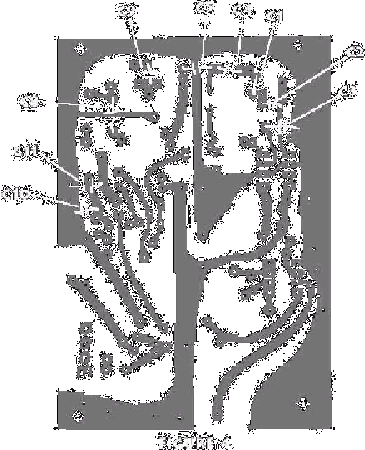
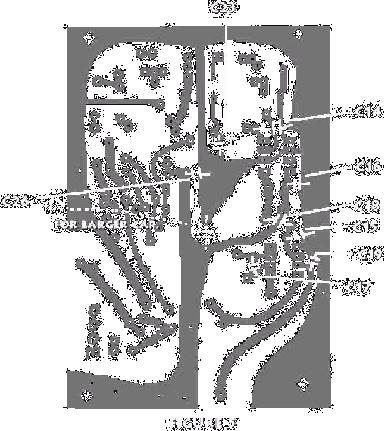
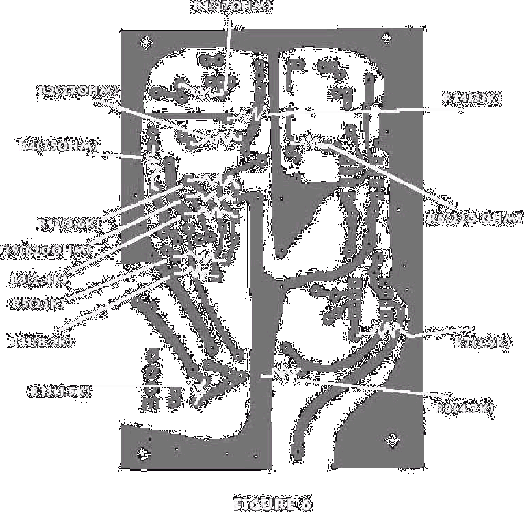
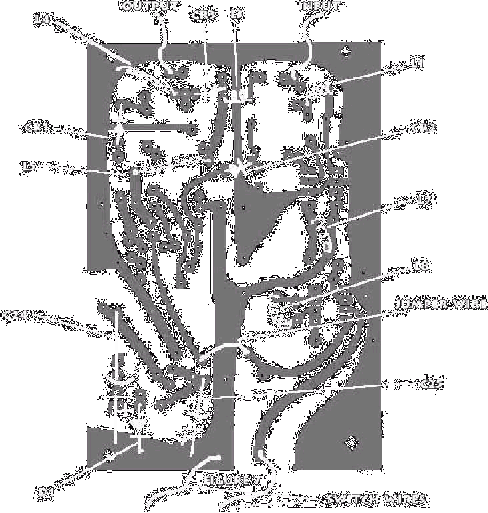

POK 3000 PCB LAYOUT
|